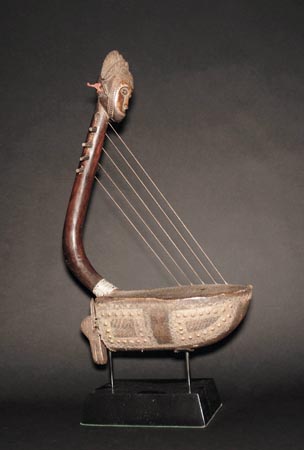
Owner: HWMC
Catalog#: AF-CHHP-12-65
http://www.uiowa.edu/~africart/toc/people/Bamana.html
Harps
Bamana Harp (ngombi)
Central Mali
Bamana
Wood, antelope and lizard skin, copper, metal tacks
Early 20th Century
Height: 56 cm (22 in); Width: 15cm (6 in); Depth: 30.5 cm (12 in)
Chordophone – Harp Beautiful Instrument / Zoomorphic Attribute / Intricate Design / Aged Surface
The Bamana people, also called Bambara, are located in an area of savannah, in central Mali. They form the largest ethnic group in this region and are members of the Mande culture (speaking) tribes. The Bamana society is structured around six male societies, known as the Dyow. Most distinctive of their artwork are their masks and Tji Wara headdresses. Until recently, the specific societies or ceremonies of these pieces were a mystery, and it has only been in the last 20 years that field research has brought knowledge to the rest of the world about the function of some of these objects. The Bamana people are oral learners. Within their culture are griots, singers or simply praisers. The griots sing the history and praise of the family, often while playing the harp or the kora (a Malian harp/guitar). This rare and beautiful five-string Bamana harp shows a golden brown patina. The top of the boat-shaped sound box is covered with a smooth antelope skin. The bottom and sides are completely covered by geometric patches of reptile skin and thin sheets of copper, held in place by handmade tacks. Protruding from the back of the sound resonator is the carved head of an antelope with low relief carvings in a zig-zag motif, which represents the sun’s course from east to west. Atop the arched bow is a detailed carved female head with a fanning coiffure or crown, as to pay tribute to an ancestor. This type of African harp structure is classified as ngombi.
